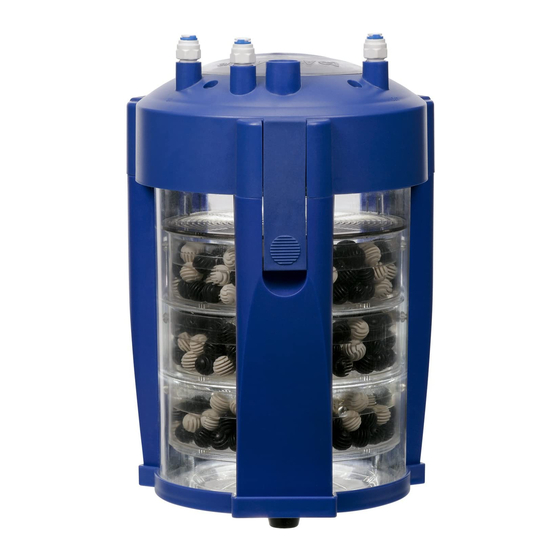Aqua Medic Nitratreductor NR Blue Operation Manual - Page 11
Browse online or download pdf Operation Manual for Aquariums Aqua Medic Nitratreductor NR Blue. Aqua Medic Nitratreductor NR Blue 18 pages.

6. Redox control
With a redox potential control, the function of the Nitratereductor can be optimized and the
reliability can be increased.
The optimal working point of the Nitratereductor can be determined by the measurement of the
redox potential.
Denitrification and redox potential
The redox potential is a parameter which can be measured electronically. The value is a
measurement for the equilibrium between reducing and oxydizing reactions in the water.
The redox potential in the aquarium itself is kept at plus 300 and 440 Millivolt. This high redox
potential indicates that oxydation reactions dominate over reduction reactions. Oxydation reactions
are biochemical reactions where a substance is oxydized, e. g. by oxygen.
A negative redox potential indicates the absence of oxygen and is lethal for most aquarium
inhabitants.
The biochemical conditions in the Nitratereductor differ completely from those in the aquarium:
Nitrate has to be reduced to nitrogen gas. This is only possible if there is no oxygen dissolved in
the water. The redox potential is low or even negative. The ideal range is between -50 and -250
mV. If it exceeds -50 mV, the denitrification reaction may stop at the nitrite stage!
If it falls below -300 mV, all the nitrate is reduced. The bacteria then start to use sulphate. This is a
very
undesired
process
Hydrogensulfide (H
S) is toxic and smells very strange like fouling eggs.
2
If a little bit of Hydrogensulfide is entering the aquarium, this is not critical. It is immediately
oxydized to sulphate. The closed version of the Nitratereductor causes no problems with bad smell.
Control of the Nitratereductor
The Nitratereductor can be controlled by the rate of feeding or the flow rate of water:
If the redox potential exceeds -50 mV or even gets positive, the dosage of food can be increased or
the flow rate decreased. Warning: Danger of nitrite! If you work with redox control and a dosing
pump, only the dosage of food can be increased.
If the redox potential sinks below -300 mV, the feeding can be reduced or the flow rate increased.
If you work with Denimar-Powder, you should keep the flow rate constant and vary the food
supply. If the redox potential sinks below -300 mV, stop feeding. If the redox potential exceeds -50
mV, double the food dosage until the potential will sink again.
If the Nitratereductor is filled with Deniballs, only the flow rate can be adjusted. In case a
dosing pump is used, a mechanical timer has to be set between the controller and pump (as
described in chapter 4) to control the flow. begrenzt. Although a slow flow leads to even more
dropping of the redox potential, possibly existing Hydrogensulfide in the aquarium is oxydized to
the harmless sulphate quickly. With a rapid flow, there is the danger of intoxication.
7. Failures
Problems with denitrification are mostly caused by wrong adjustion of the flow and feeding rate.
They can only be determined by measurements of the nitrite and nitrate concentrations in the filter
or by measurement of the redox potential.
-
The pump makes noise: If the pump housing contains air, this causes a strong noise. In this
case, the pump is pumping little or no water and its cooling is insufficient. The pump may
overheat and be destroyed. The plastic elbow at the pump outlet has a small hole where air can
escape. If this hole is blocked, it has to be cleaned with a needle.
because
the
end
product
of
this
reaction
is
Hydrogensulfide.
11
